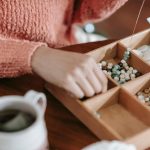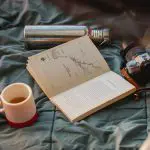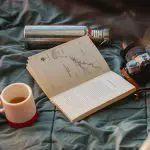If you're looking to add a touch of vintage charm to your fabrics, tea staining might be just what you need. By using simple techniques, you can transform plain textiles into rustic pieces that evoke a sense of history. You'll want to consider the fabric type, the right tea selection, and various staining methods to achieve the desired effect. Whether you prefer a soft, subtle hue or a bold statement, there's a process that suits your vision. But before you start, let's explore how to prepare the perfect staining solution and what to keep in mind during the process.
Table of Contents
Key Takeaways
- Choose natural fabrics like cotton, linen, or silk for optimal tea absorption and vintage effects.
- Prepare a staining solution by steeping 4-6 tea bags in 4 cups of boiling water for 15-30 minutes.
- Experiment with various staining techniques like dip dyeing, spray staining, or crumpling for unique patterns.
- Dry the stained fabric flat in a shaded area and iron on low to set the stain securely.
Understanding Tea Staining
Tea staining is a simple process that transforms your fabric into a beautifully aged piece, giving it a vintage look. This method involves using tea as a dye, which can create a range of warm, earthy tones.
The beauty of tea staining lies in its accessibility; you can easily do it at home with items you likely already have in your kitchen.
To get started, gather your materials: fabric, tea bags, and hot water. Brew a strong pot of tea, letting the bags steep longer for a richer color.
Once the tea is ready, immerse your fabric in the liquid. The longer you soak it, the darker the fabric will become, so keep an eye on the color development.
After you achieve your desired shade, rinse the fabric in cold water to set the color, and hang it to dry.
Choosing the Right Fabric
When selecting fabric for tea staining, you'll want to consider the type of material you're using.
Different fabrics absorb tea differently, affecting the final color and texture.
Choosing the right combination can enhance that vintage look you're aiming for.
Fabric Types for Staining
Choosing the right fabric is crucial for achieving those beautiful vintage effects you want with tea staining. Natural fibers like cotton, linen, and silk are your best bets, as they absorb the tea dye effectively, creating that rich, aged look.
Cotton is especially versatile; it comes in various weights and weaves, making it perfect for everything from quilt patches to clothing. Linen, with its slightly uneven texture, adds an authentic rustic charm that enhances the vintage feel.
Silk can also yield stunning results, although it may require a more delicate approach due to its luxurious nature. Avoid synthetic fabrics like polyester or nylon, as they often resist dye absorption and won't give you the desired effect.
When selecting fabric, consider the weight and weave. Heavier fabrics may take longer to stain but can create deeper tones, while lighter ones will yield softer hues.
Always prewash your fabric to remove any finishes that might hinder dye absorption. By choosing the right fabric, you set the stage for a successful tea staining project that captures that cherished vintage aesthetic.
Color and Texture Considerations
For achieving the best vintage effects, consider how color and texture will interact with your chosen fabric during the staining process. Different fabrics absorb tea differently, so it's crucial to choose wisely.
Natural fibers like cotton, linen, and silk tend to soak up the stain more effectively, creating that authentic aged look you're after. Synthetic fibers, on the other hand, mightn't deliver the same results, often leading to uneven coloring.
When it comes to color, think about the base shade of your fabric. Light-colored fabrics will absorb the tea more readily, resulting in a deeper, richer hue. However, darker fabrics may only yield subtle changes. If you're aiming for a specific vintage tone, consider pre-dyeing your fabric in lighter shades.
Texture also plays a vital role in how the stain settles. Fabrics with a more textured surface, like burlap or muslin, can create unique patterns as the dye seeps into the fibers.
Ultimately, choosing the right fabric, considering both color and texture, will enhance your tea staining project, ensuring you achieve the vintage effects you desire.
Selecting Your Tea
Selecting the right tea is crucial, as different varieties can create unique shades and effects on your fabric. You'll want to choose a tea that not only meets your aesthetic goals but also complements the texture and color of your material.
Here are three types of tea to consider for your project:
- Black Tea: This is the classic choice for a rich, deep brown hue. It's perfect for creating that nostalgic vintage look, reminiscent of antique fabrics.
- Green Tea: If you're aiming for a softer, lighter shade, green tea might be your best bet. It can yield subtle, warm tones that bring a fresh, delicate feel to your fabric.
- Herbal Tea: Varieties like chamomile or hibiscus can add unexpected colors and delightful scents to your project. These can offer warm yellows or rosy pinks, creating a unique vintage vibe that stands out.
Whichever tea you choose, remember to experiment first. Swatches can help you visualize the potential outcome and ensure you achieve the perfect vintage effect for your fabric.
Happy staining!
Preparing the Staining Solution
After picking your tea, the next step is to prepare the staining solution to ensure it's ready for application on your fabric.
Start by boiling about four cups of water in a pot or kettle. Once the water reaches a rolling boil, remove it from heat and add your chosen tea bags. For a deeper stain, you can use four to six bags, depending on how dark you want the final result to be. Let the tea steep for at least 15 to 30 minutes; this allows the color to intensify.
After steeping, carefully remove the tea bags. You can add a tablespoon of vinegar to the solution if you want to help set the color. This step's optional, but it can enhance the longevity of the stain.
If you have a larger piece of fabric, consider doubling or tripling the solution for even saturation. Once you're satisfied with the color, let the solution cool down to a safe temperature for handling.
You're now ready to apply the staining solution to your fabric, setting the stage for beautiful vintage effects.
Staining Techniques and Tips
Experiment with different staining techniques to achieve unique vintage effects on your fabric. Each method can bring out a different charm, so don't be afraid to play around.
Here are three techniques you can try:
- Dip Dyeing: Submerge your fabric partially in the tea solution for a gradient effect. This adds depth and creates a stunning visual contrast that draws the eye.
- Spray Staining: Fill a spray bottle with your tea solution and lightly mist the fabric. This technique gives a soft, diffused look that's perfect for adding a touch of whimsy to your projects.
- Folding and Crumpling: Before staining, fold or crumple your fabric. When you apply the tea, the uneven surface will capture the stain in unique patterns, evoking an authentic vintage appeal.
Drying and Setting the Stain
To ensure your tea stain sets properly and achieves the desired vintage effect, it's crucial to dry the fabric correctly.
Start by gently blotting the fabric with a clean, dry cloth to remove any excess tea. Avoid rubbing, as this can cause the stain to smear.
Next, lay the fabric flat on a clean, dry surface away from direct sunlight. Sunlight can fade the stain, so choose a shaded area. If you're working with larger pieces, consider hanging the fabric on a clothesline using clothespins, ensuring they don't touch each other to prevent uneven drying.
For quicker drying, you can use a fan on a low setting, directing the airflow towards the fabric. Just make sure it's not too strong, as that might disturb the stain.
Once the fabric is completely dry, you might want to set the stain further by lightly pressing it with an iron on a low setting. This can help lock in the color without damaging the fabric.
After these steps, your tea-stained fabric should be ready for its next creative application, showcasing that beautiful vintage look you aimed for!
Creative Applications for Stained Fabrics
Tea-stained fabrics can transform everyday items into unique, vintage-inspired decorations that add character to your home. You might be amazed at how a simple stain can breathe new life into old textiles.
Here are three creative applications you can try:
- Cushion Covers: Give your living space a cozy, rustic vibe by sewing tea-stained fabric into cushion covers. The warm hues will invite relaxation and make your home feel more welcoming.
- Wall Art: Frame pieces of tea-stained fabric to create stunning wall art. The organic patterns and colors can evoke a sense of nostalgia, making your walls come alive with stories.
- Table Runners: A tea-stained table runner can elevate your dining experience. Pair it with vintage dinnerware and some fresh flowers for a charming tablescape that's sure to impress your guests.
Frequently Asked Questions
Can I Use Herbal Tea for Staining Fabrics?
Yes, you can use herbal tea for staining fabrics! Herbal teas like chamomile or hibiscus can create unique colors. Just brew a strong infusion, soak your fabric, and let it dry for beautiful results.
How Long Will the Tea Stain Last?
The tea stain can last for years if you properly set it. Washing the fabric in cold water and avoiding harsh detergents helps maintain the effect, so you can enjoy that vintage look longer.
Is Tea Staining Safe for All Fabric Types?
Tea staining isn't safe for all fabric types. You should avoid delicate fabrics like silk and some synthetics, as they can be damaged or discolor. Always test a small area first to ensure compatibility.
Can I Remove Tea Stains From Fabric?
Yes, you can remove tea stains from fabric. Start by rinsing the stained area with cold water, then apply a mixture of mild detergent and vinegar. Gently blot and rinse until the stain disappears.
What Tools Do I Need for Tea Staining?
You'll need a few essential tools for tea staining: tea bags or loose tea, a heat source for boiling water, a bowl for soaking, and gloves to protect your hands. Gather these before you start!
- Chino vs. Gabardine: Which Trouser Fabric Is Right for You? - June 24, 2025
- A Review of Michael Kors’ Jet Set Nylon Gabardine Crossbody Bags - June 24, 2025
- What Does ‘Gabardina’ Mean? From Spanish Term to Fashion Staple - June 24, 2025







